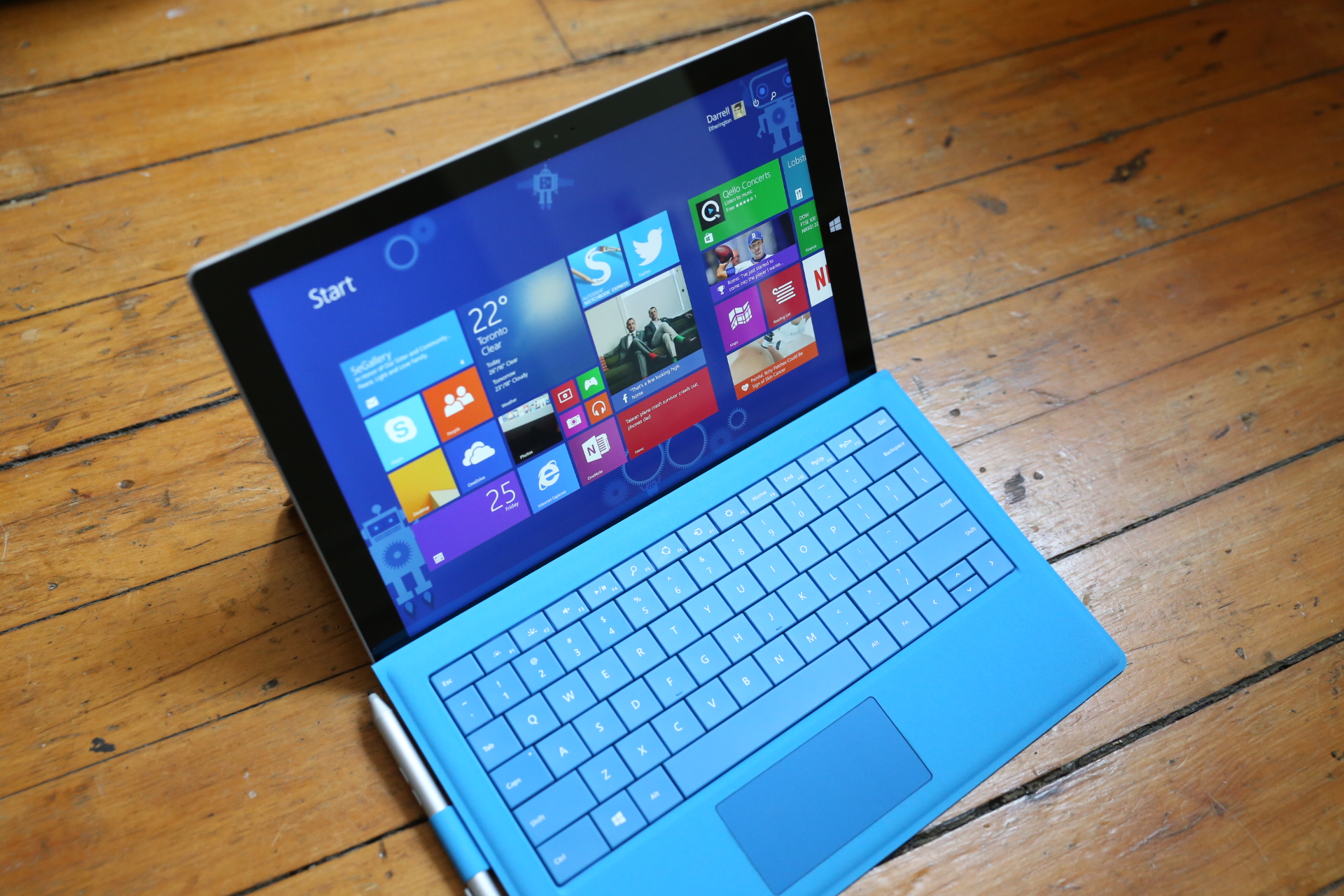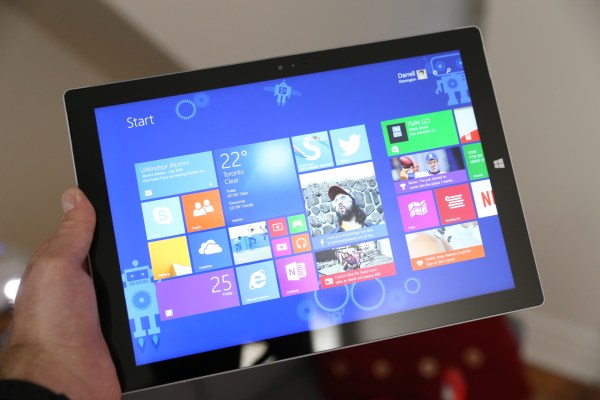Microsoft has a new Surface tablet/PC hybrid, and it’s a departure from their first- and second-generation versions of the Surface line, with an all-new design and a bigger, better display. The device is basically the perfect partner for Windows 8 and the Modern Windows UI, but your appreciation of this device (or lack thereof) will depend heavily on what you want to do with your computer. We looked at it back when it launched, but how does it stand up to extended use?
Basics
- 12-inch, 2160×1440 display
- 9 hours battery
- Intel Core i5 Processor
- 128GB flash storage
- 5.0 megapixel front/rear camera
- 1.76 lbs, 11.5″ x 7.93″ x 0.36″
- MSRP (as reviewed): $799
- Product info page
Pros
- Portability relative to power
- Great industrial design
Cons
- “Lapability” still not great
- Price (especially factoring in accessories)
Design
Microsoft has consistently done at least one thing right with the Surface line of devices, regardless of whatever else people think about the machines – they deliver great examples of modern industrial design, from the magnesium alloy used in the case construction to the engineering feats required to fit a full computer’s internals inside the slim devices. The Surface Pro 3 continues this tradition of great design, with a new lighter look that works well, a slimmer case, and a bigger, more usable 3:2 ratio display that captures a user’s full attention when it’s active.
[gallery ids="1035054,1035052,1035053,1035055,1035056,1035057,1035051"]
The new kickstand on the Surface Pro 3 is also a big improvement, and even though I admittedly poked fun at a built-in kickstand on the original Surface, it has indeed proven useful in every generation of the machine. This time, the full range of motion is available instead of just a few select lock positions, and that’s a big advantage for using this thing around the house, and for digital art, which is one of my primary use cases in a Surface.
There are still some quirks in the design – despite losing weight, it’s still heavy if your expectations are set based on coming from an iPad, and the screen size, despite offering a better movie watching and graphics work experience, means that using it handheld is a little bit more awkward than before. Overall, though, it’s definitely an improvement on previous generations when it comes to design.
Features
Microsoft has learned from its past releases and created features for the Surface Pro 3 that greatly benefit the overall experience. The kickstand mentioned above offers a big advantage in terms of how usable the Surface Pro 3 is in various situations, including while used on your lap. The new click shortcuts for the pen are also great, including using a long press to automatically open OneNote and begin a new blank document, even when the computer is asleep with the screen turned off.
They may not be new, but some existing features of Windows 8 also come in handy, and shine especially bright on the Surface Pro 3. Chief among these is the ability to run apps side-by-side in a windowed mode that splits the screen among them. This makes multitasking while keeping an eye on Twitter easy, and the additional screen real estate afforded by the new Surface Pro 3 display makes using the feature feel a lot less cramped.
Based on my usage of the device, it’s hard to understate the value of the new OneNote auto-launch functionality using the pen. The Surface Pro is basically the perfect digital handwritten notetaking tablet, and this really ups its value in that regard. But the pen also loses some tricks in the switch from Wacom to N-Trig as a provider, including automatic flip-to-erase functionality in drawing programs, and that’s less than ideal.
Performance
The big value proposition behind the Surface Pro 3 has always been its ability to run full-powered Windows applications despite having a portable, tablet-style form factor. The Surface Pro 3 isn’t a huge advancement in terms of performance over the Surface Pro 2 in this regard, but it does push the needle a bit. During some activities, however, including unlocking the device and rotating the screen, I actually felt that the Surface Pro 3 was a bit more prone to lag and delays than the Surface Pro 2.
Once active, apps and games performed well, and despite having read elsewhere that drawing responsiveness was less than stellar compared to the Surface Pro 2, I found in my use that it was still more than acceptable when working with the new, Surface Pro 3 high-density display optimized version of Photoshop CC, and with Autodesk’s Sketchbook Pro. The new digitizer doesn’t have anywhere near the levels of sensitivity of the one provided by Wacom on the Surface Pro 2, but for light digital painting, photo editing and cartooning (my uses), it works well enough that many probably won’t notice a difference.
Screen

The display on the Surface Pro 3 is one of its standout features – the high density resolution makes it great for watching movies or Netflix, and for using the Windows Modern UI. The classic desktop will be harder to navigate for those with old eyes or vision problems, because it renders individual elements so small, and that’s true of apps not built for HiDPI screens, too.
Overall, though, Microsoft has really outdone themselves with this screen, and that’s just another part of what makes this machine so useful for those working in digital artistic fields.
Battery
Battery life on the Surface Pro 3 is rated at 9 hours of web browsing usage, and it definitely feels more long-lasting than the one found in the Surface Pro 2. If you’re coming from a notebook you’ll be pleasantly surprised, but for video streaming and intense graphic application usage, you’ll likely find it doesn’t reach near that nine-hour mark. Again, this is a situation where your origin point will determine your reaction: coming from a tablet could make battery feel inadequate, but transitioning from the PC world, you’ll be pleasantly surprised.
Bottom Line
Microsoft is touting the Surface Pro 3 as a device that eliminates the consumer question of “tablet, laptop or both?” and to some extent, it can do that. But answering that question with the Surface Pro 3 means making other concessions, too – despite the marketing push, it’s not a perfect ‘have your cake and eat it, too’ scenario. Windows 8 is not everyone’s cup of tea, for instance, despite improvements made with Windows 8.1. And the software library for Modern Windows is still such that you may not be able to find everything you’re looking for.
The fact is that despite its merits, the Surface Pro 3 is still a niche device – but for a couple of very different niches. It could work great for someone looking for a single computer solution that’s closer to an iPad but with a larger display and a little more range in terms of approximating a desktop; and it could be great for a digital artist looking for something to use away from their home setup. It’s a solid machine and an example of well-executed hardware engineering, but at $799 plus the cost of a $130 Type Cover, it might still have a few too many quirks and peculiarities for the average user. For those who fit the profile, however, there’s nothing else quite like it.
